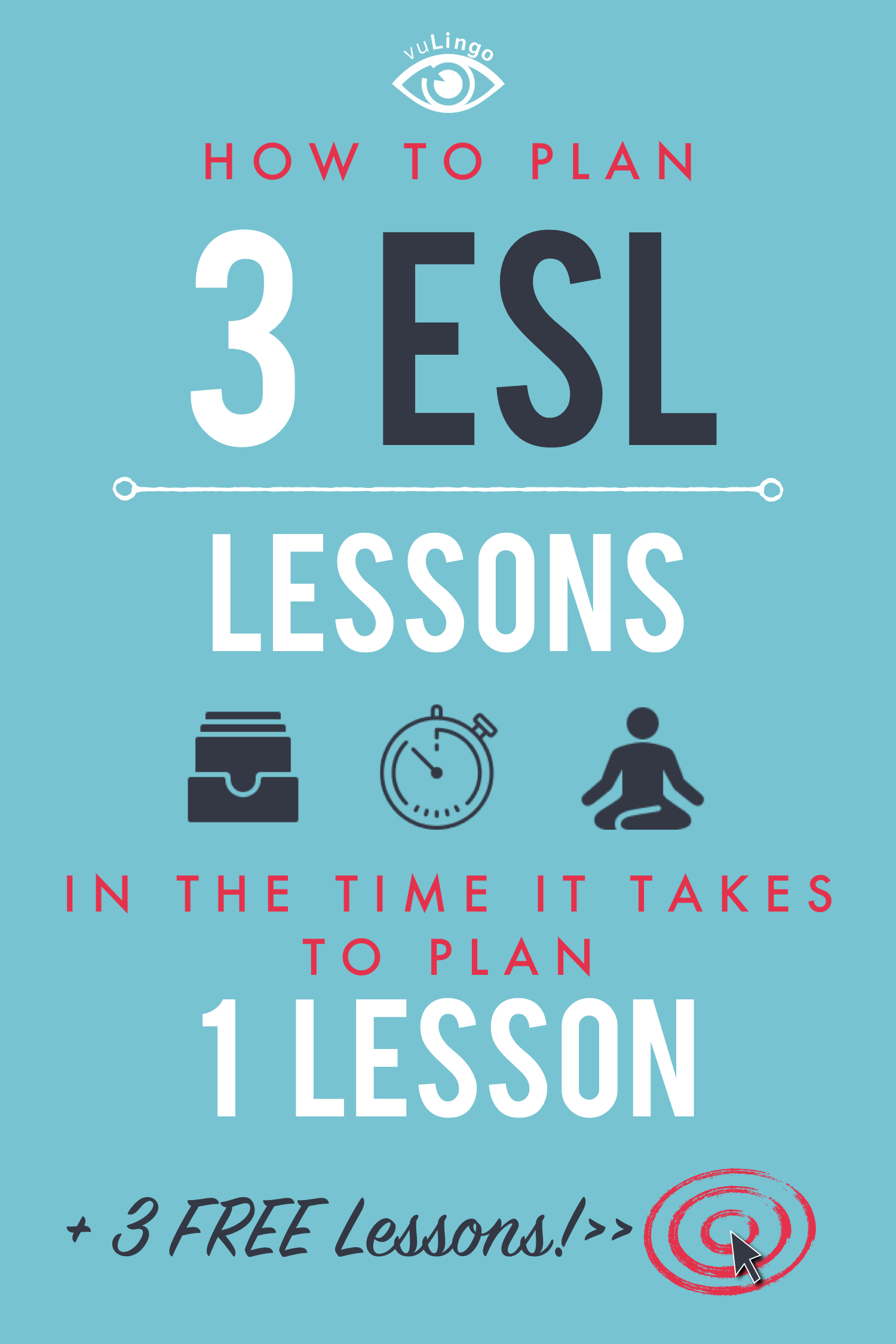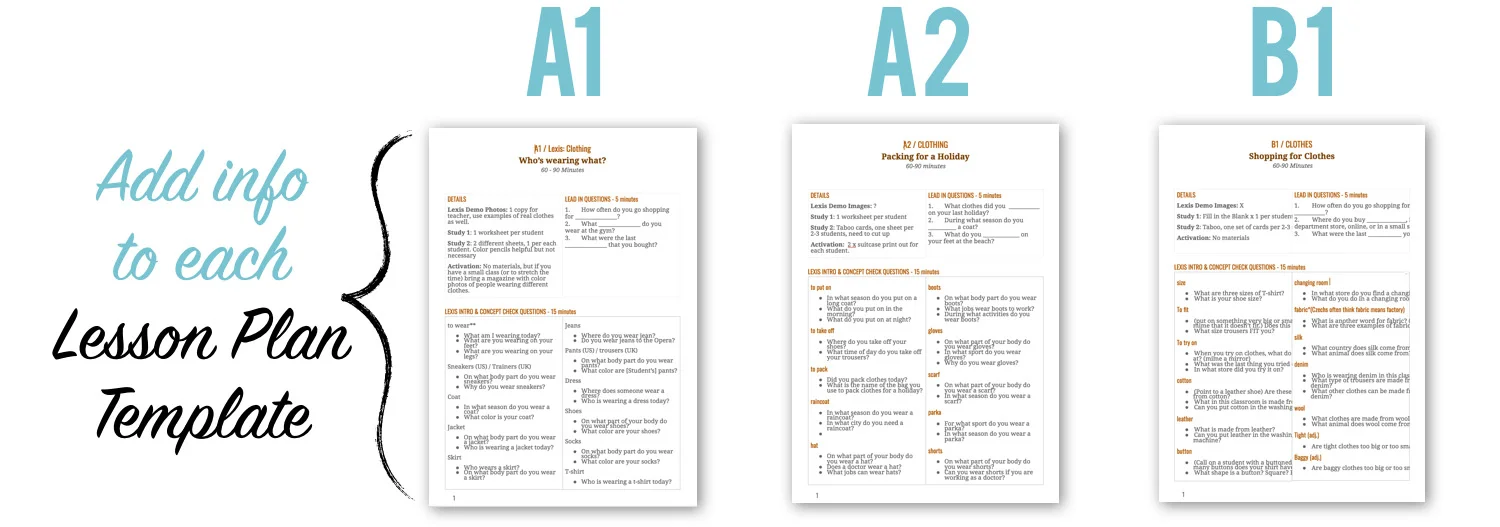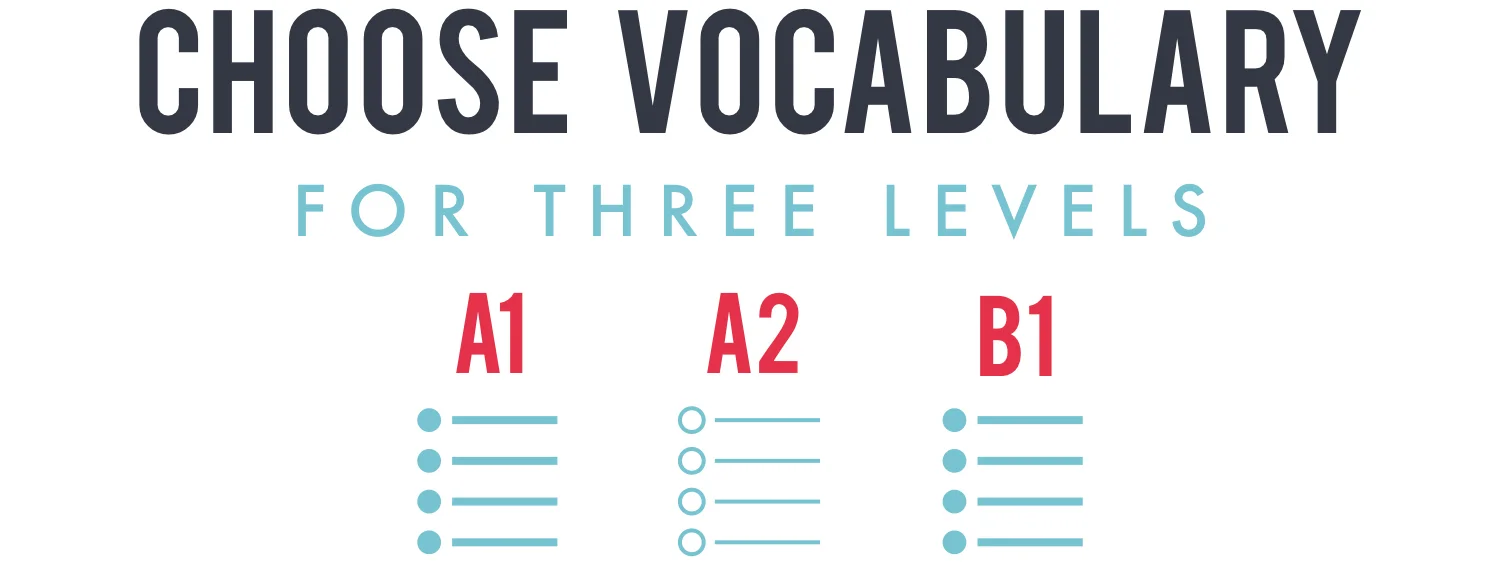Lesson Planning—oi veh. The bain of a good language teacher's existence.
I say "good teacher" because bad teachers don't lesson plan. They go into a classroom unprepared and try their hand at "winging it." Bad teachers download rando exercises from questionable internet resources, spotted with errors. Bad teachers bribe someone in the teacher's lounge for extra copies of whatever they just taught.
Okay, I admit it. I've been a bad teacher. We all are sometimes.
But we're trying to be good, right? We love our students after all, and we want them to succeed. We want to be good teachers. But it's just...the lesson planning! THE LESSON PLANNING! Sometimes it's just too much.
So my goal today is to cut your lesson planning by a whopping two-thirds! That's right. We're going to plan three lessons for three levels in the time it used to take you to plan one. That's a big chunk of time! What are you going to do with that extra hour or two? What if at the end of this blog post, I gave you those 3 FREE LESSONS, all planned up and ready to print? Would that be worth a 10 minute read?
But hold the phone! I'm going to show you how to cut ALL your lesson planning by two-thirds. Holy cow, that's like 10...20...30 million hours of unpaid work that I've just saved you from! Okay maybe not that much, but you could definitely squeeze out an extra daily nap, yoga session or Netflix binge.
So let's get this show started, we don't have all day!
The first step in this streamlined lesson planning method is to pick one category of vocabulary, which you'll use for all three lessons. I keep the list of official list of Cambridge test prep words (for the KET, PET, FCE etc.) easily accessible in my Trello for TEFL System (wait for it) so they're right where I need them when I'm lesson planning. The lists conveniently divide the level-appropriate words into subject categories like "transportation" or "food & beverage" or "entertainment" and much more.
Almost every group of vocabulary can be split up into three levels (many more actually). Take "entertainment": A1 can learn the basics like television, radio, film, book; A2 can learn genres like comedy, drama, thriller; B1 can learn various musical instruments like drums or entertainment professions like director. Briefly think of a few examples of words in that topic at three different levels so you know you're on the right track.
Today I'm going to choose "Clothing & Accessories" as my topic. So for A1: trousers, shirt, to wear; A2: high heels, swimsuit, to put on; B1: baggy, fabric, to fit. Sounds good to me, let's move on.
The activation is last exercise of my lesson (about 20 minutes long). It's when I push the students out of their nest to use what they've just learned. An activation exercise simulates a scenario where they'd naturally use the target language. A scenario can be "buying a car" or "sick at the doctor's office" or "lost in a new city."
A good activation will prompt the student to use almost ALL of the target language they've just learned. That's why I work backward in lesson planning, from the last exercise (the activation) to the first. I don't want to waste time creating a fabulous Study 1 & Study 2, and then realize I've included vocabulary that's not natural in that role-play.
For example, if one of my activations has my student shopping in a clothing store, I might include the words blazer or tight or size, but costume or uniform might be hard to realistically include in that role-play, even though those words are all at an A2-B1 level.
So what are three scenarios where my students would use "clothing & accessories" vocabulary naturally?
For one, I like the clothing store idea—one student can be the salesperson, one can be the customer. That will be good for my B1 students, eliciting expressions like "The shoes fit." and "I'm looking for a wool coat."
Packing for a vacation (with a partner) is another situation where lots of clothing vocabulary can be used, like sandals for a tropical holiday or gloves for a ski trip—perfect for my A2 students.
And for my A1 beginners, I'm going to keep it simple and play "Who's wearing what?" where I have them describe each other's clothing and switch partners again and again.
But I can't just tell a pair of students: "You're a salesperson, you're a customer—discuss!" A good activation has a goal. The goal is the fuel of the discussion. Maybe the customer is buying clothes for a special occasion for her and her partner, but the store only has a limited selection—I can imagine a lot of back and forth there.
Whatever the goal of the scene, try to imagine the students using most if not all of the vocabulary they've just learned. Keep your plan loose here, you can always tighten the scenarios in the next step.
Easy, peasy. Onward.
Now that we have our scenarios, It's very easy to pick out words that will naturally be used in those situations. I choose 12-15 words, and try to include a few nouns, verbs and adjectives, making sure they all have specific relevance to the activation scenario. (Baggy is a specific adjective for a dressing room scenario, but pretty might be too general. Get me?)
Once you've got the list of words for each level, the activations should be shaping up in your mind—you should be able to envision your students using most if not all of them while acting out their role-play. Now you want to give your students the tools to learn the vocabulary...
We are flying along here, and so far we've only done the brainstorming!
Creating Studies 1 & 2 used to stop me in my tracks, but that's because I used to begin the lesson plan there! Dumb idea! Staring at a blank page 20 minutes before a lesson, trying to come up with a couple studies is the ass-backwards way to lesson plan. It's also the biggest way to get stomach stress cramps and end up with some crappy mistake-riddled exercise from the internet as a last ditch planning effort.
But once you've done steps 1, 2 & 3, you're three-quarters of the way there, seriously. The purpose of Study 1 & 2 is to get the students comfortable with the vocabulary so they can use it in the activation, which you already have!
On a side (but important) note, here's the reason I don't like getting studies from the internet: 75% of the time, random exercises are not geared towards an activation. Often they're just filler material, and mostly directed towards small kids, whom I don't often teach. Sometimes I look to their structure for inspiration, but then I created my own pack of exercise templates, included in the Trello for TEFL system. I easily add in vocabulary and photos from Google images, and voila!—fresh exercises perfectly tailored to my brilliant activations, without errors or janky British/Australian English words (Joking! I do teach trousers, but I can't bring myself to teacher jumper, sorry.)
Study 1 should be a closed study, meaning the answers should be black and white, without room for interpretation. For A1, I'm going to plug the vocabulary into my Picture Matching Template, and add some Google images, which takes about 5 minutes. For A2, I'm going to use my Word Scramble Template, which is a little more challenging for the student. And for B1, I'm going to get creative with a Fill-in-the-Blank Template because I want B1 to be working with words more than pictures.
Study 2 should be an open study, meaning I want the students to generate the words on their own. For A1, I'll include some Body Templates, and have pairs dictate what each one is wearing, while the other one draws. For A2 & B1, I'm going to make life super easy on myself and give them the same exercise, but with different words. I'll cut up cards with the vocabulary on each, and have them play a game of Taboo (they have to describe the word on the card, without using the other words listed on the card).
And viola! It used to take 30 minutes to plan one lesson, but we've just planned 3 in the same span of time, saving ourselves a full hour!
But wait, the final step is going to save your future self TWO to THREE TIMES that much—EVERY SINGLE WEEK. Trust me. This is where the power of the lesson planning system goes nuclear.
Let me stop you because I know what you're thinking...you don't need three lessons, you need one, and you need to be able to plan that one lesson three times faster.
Let's take a breath and assess your situation, shall we? (I know exactly where you are, because I've been there 3 dozen times before.)
You think you only need one vocabulary lesson right now, for your A2 class tomorrow morning. But what you don't realize (because you are not a fortune teller, nor do you plan lessons 3 weeks ahead) is that you will need a B1 Level "clothing & accessories" vocab lesson about two weeks from now (the day after a long weekend) and you'll need that A1 Level "clothing & accessories" lesson a month from now because your school is going to ask you (at the last minute) to sub for a sick teacher in her beginner's class. If you had only planned those three lessons at once! And saved them! WHERE THE HECK DID YOU SAVE THEM?! Oh. You didn't save them. Whoops.
You my dear, harried teacher are playing a defensive game.
You are only reacting to tomorrow's schedule. Or if you really have your sh*t together, you might even be reacting to next week's schedule. But your game is not offensive. You have no plan to kill the beast.
Tell me how familiar this sounds: You're half way through planning a grammar lesson (ass-backwards, probably, like I used to) and you think to yourself, "Hey wait a minute, I've planned this before. Where the heck is that lesson plan? Or the exercises? Did I type it? Why can't I find it on my computer? Is it on my roommate's computer? Where is my roommate.
Oh no...did I—?
I wrote it on the back of the gas bill. F@#%*&!!!!
There goes my lunch hour.
What is your system?
Wouldn't it be great it you had one place to keep these 3 x free lesson plans I'm about to send you? Not in the abyss of your email or in a stack of papers on your desk, but in an online teacher's lounge, complete with every exercise you've ever written, borrowed or stolen?
And what if you could see, in that very same system, every single class you will teach, planned months in advance? What if you knew you could teach the same exact lesson tomorrow, next Tuesday and the day after you return from vacation, without re-planning a thing? What if you just logged in to your student's syllabus, where you found the entire lesson, happily waiting to be printed?
Don't imagine it. Make it happen. Stop letting the job steal your free time.
Here are the three lesson plans we worked (not so hard) on. I hope the time they save you inspires you to batch-plan the rest of your month.
Not in the Trello for TEFL Tribe yet? Get your lesson plans here>>
And if you want to supercharge your planning (or supercharge your laziness—I'm super lazy now that I use the Trello for TEFL system!) you can learn more about my system right here>>















